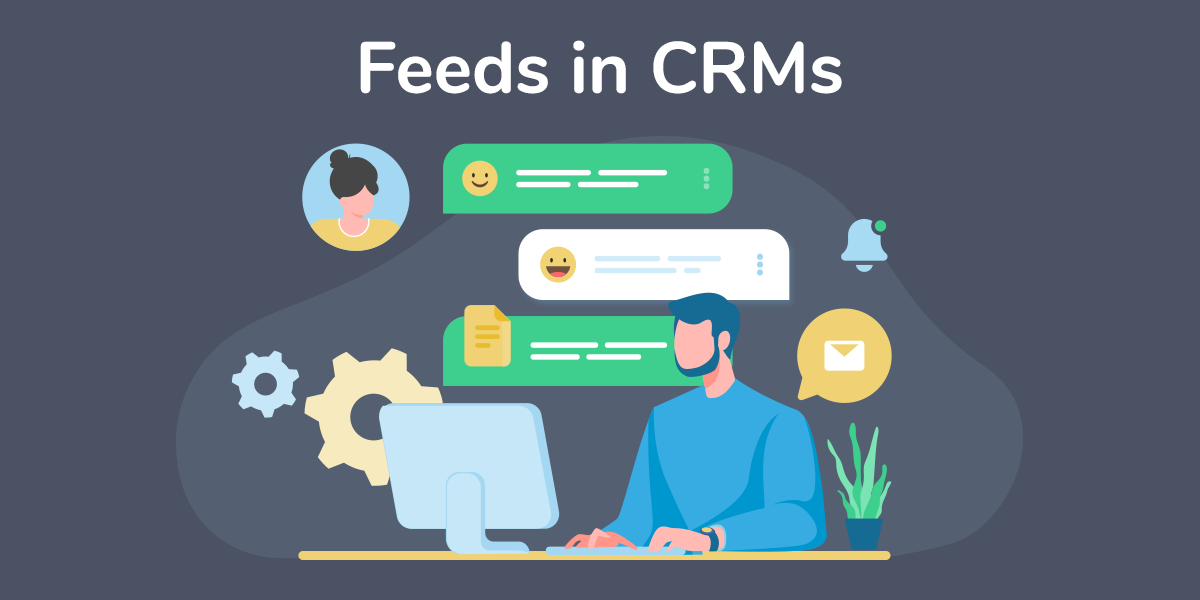82% of companies worldwide rely on Customer Relationship Management software, also known as CRMs, to manage their sales pipelines and marketing communications. Right now the largest players in the industry are doing their best to strengthen their position in the marketplace, and with an addressable market estimated to be worth nearly $150 billion by the end of the decade it isn’t difficult to understand why. But developers looking to disrupt this space need not be dissuaded: by utilizing feeds to their full potential, your CRM can stay one step ahead of the competition.

The need for feeds
Feeds exist in two ways: activity feeds and object based feeds. Twitter is a great example of how activity feeds operate: each post can contain text, images, videos, or combinations thereof. Users from across Twitter can be tagged via @ mentions, and users can reply in threads contained under the posts. Whole conversations occur with little confusion or backtracking, because the threaded replies keep things organized for the end users.
Object based feeds provide all the functionality of a feed, but centered on an object, or element, of an app.
Give context to communication
At Weavy we’re big advocates of contextual collaboration. Contextual collaboration is that collaboration about work should take place in the app where the work is being done. You’ve encountered contextual collaboration before: the “comment” and “suggest edits” functions in Google Docs, or the “chat” function in Zoom are great examples of limited contextual collaboration. In practice, contextual collaboration saves you the trouble of having to navigate away from where you’re presently working to ask a colleague a question or share an important file, digitally recreating some of the benefits of an office environment..
In a CRM the need for contextual collaboration be self-evident, there’s a lot of time spent prospecting, discussing, and qualifying leads. Due to the limitations of most CRMs, this work is often divided across several tools, including but not limited to project management software, communication software, and the CRM itself. To be blunt this is, in the words of many a midwestern aunt, completely bass ackwards: there’s no logical reason that all of this functionality shouldn’t be fully baked into a CRM.
Using object based feeds, a CRM could allow users to have entire activity feeds centered around a contact, a company, or a deal. These feeds are places where users can share updates, give feedback, comment, or even post images and upload relevant files. This layer of context means less time wasted and less confusion when discussing similar deals or leads. Object based feeds give users the ability to create spaces dedicated to the task they’re working on in the most logical place possible: where they’re working on it.
Making the dream work with teamwork
The size of the average sales team is about 10 to 12 salespeople for every one sales manager. That means a dozen people in your CRM working towards the same goals. Unfortunately, now that hybrid work has become the norm, many people in these teams can be left to feel as if they’re working towards these goals independently. Research has shown that fostering communication within a team can increase productivity by as much as 25%, and that continuous training and feedback can improve individual sales performance by as much as 50%.
In the past I’ve talked about how bringing chat into your app can help make your CRM more collaborative for sales teams, but feeds takes this to another level by allowing sales teams to build a virtual workspace within your app. In fact, that’s something we’ve been doing here at Weavy for years. Every team within our company has a dedicated activity feed where we post updates, ask questions, answer polls, or just share the latest news. On the sales side of the equation that often means using our commercial team feed to solicit and give feedback, here’s an example of how it’s worked for us:
How Weavy uses feeds to empower Sales
Some time ago one of our customer success managers had a discovery call with a lead. The success manager worried that he had misinterpreted a question and given an incorrect answer. He posted a recording of the call and asked the team for their feedback on how we thought it went. In the comments we had a discussion where we came to the conclusion that our teammate had messed up. This led to a conversation about how he could prevent this situation in the future, and the next steps to take with the lead.
A few days later this same manager posted a recording of another call where something similar happened, only this time he made sure to clarify what was being asked before giving an answer. This discovery call ultimately led to a successful enterprise sale.
By utilizing feeds this way, our team was able to solicit and give feedback, which led to a better sales outcome and ultimately provided fodder for upcoming sales trainings. The biggest problem in this situation was that we were using Feeds in our own internal app. If feeds were integrated into Hubspot, the CRM we rely on here at Weavy, we’d not only have a communal space to discuss leads and process, but we’d be able to have those conversations be linked to the contacts we’re discussing. This little change would make our CRM the place where almost all of our work was accomplished.
The CRM business is growing, and as market conditions lead to more tech workers branching out and starting their own businesses, the competition will only heat up. To stay ahead of the biggest players, an easy way to set yourself apart is to make sure your CRM is centered around the most important aspect of sales: the teams. By bringing your users to the forefront of the CRM experience, you have an opportunity to make your CRM more powerful and more competitive.